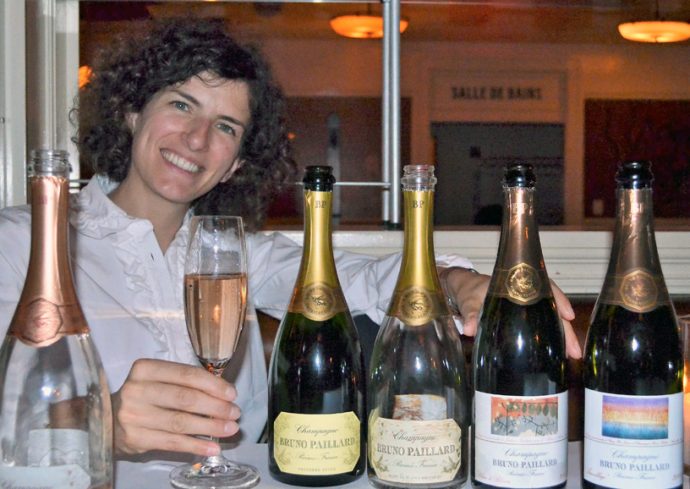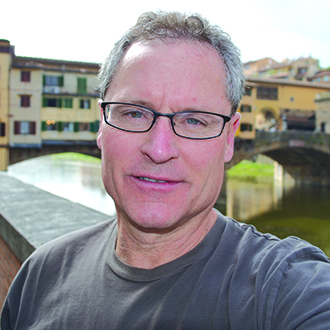With the holidays just around the corner, wineries that produce sparkling wines are getting busy.
Decades ago the Champagne region did an amazing job linking its wines to celebrations. New Year’s Eve, weddings, anniversaries, business triumphs and political successes are applauded and sealed with a Champagne “pop” and pour. Indeed, almost a quarter of Champagne’s massive annual bubbly production is sold in December. I recently attended a dinner and a tasting of Bruno Paillard Champagnes in Manhattan. Alice Paillard, a daughter of winery founder Bruno, was just settling in after a transatlantic flight. I arrived at the restaurant about a half-hour early and immediately recognized her from the promo pictures, grabbing a small bite near the bar. She invited me to sit and talk about her wines, one-on-one.
“We are the youngsters on the block,” Alice said. It’s very rare for a new Champagne house to originate. Usually smaller family-owned houses are bought up by the mega producers so there is a diminishing autonomy in the Champagne region. Bruno Paillard had worked in his family’s multigenerational brokerage house in Reims, hooking up growers of Champagne grapes with producers of Champagne. At age 27 in 1981, Bruno decided he wanted to make Champagne but only a premium and pure Champagne. So he sold his one possession of value, a vintage Jaguar, bought some grapes from a grand cru vineyard — grand cru, or “great growth,” indicating a favorable rating — rented a cellar with some winemaking equipment and got busy.
From the beginning the goal was to buy grapes from top tier grand cru plots where the grapes have accented flavors of fruity acids and flowery elements with a backbone of a steely, mineral quality, picked up from the limestone and chalky soils. Bruno used only the premium juice of the first pressing of the grapes from the best plots he could find. In 1994 he bought his first vineyard, a seven-and-a-half acre grand cru plot, which gave him more control from vine to bottle. He employed sustainable and organic principles before that was popular and now uses no herbicides or pesticides in the vineyard. He and his staff plant flowers liberally, which is, of course, aesthetic, although their function is more important. Roses, in particular, are more sensitive to certain fungi than grapes. If there is evidence of a fungal attack on the roses, the vines will be next. This “canary in a coal mine” approach helps minimize intervention. The flowers also attract pollinating birds, bees and butterflies, helping to breathe life into the vineyard.
By 1990 Bruno began building his own high-tech winery. Today he owns 79 acres of vines in 100 distinctly different plots in Reims, with 30 of those acres labeled grand cru. In 2007, Alice joined the business and today is co-manager of the brand, jumping in to all aspects of the house, including vineyard management, winemaking, media relations and sales and exports. Bruno Paillard was the first in Champagne to print the disgorgement date on the label. Disgorgement is the process unique to sparkling wines in which the sediment is coaxed into the upper neck of the bottle by tipping it in a special rack over a few weeks until it’s practically upside down. Finally, the bottle necks are frozen and the cork pulled so the ice plug of sediment is expelled and the bottle is topped off with a touch of wine.
“Champagne is not just a celebratory drink,” Alice said. “It’s a wine. It pairs wonderfully with many meals and cuisines.” Champagne can be made with Chardonnay, Pinot Noir and Pinot Meunier grapes. Each type of grape and each grape plot is vinified separately into a still wine and then carefully blended to complement the others’ flavor profiles. Each individual still wine changes at its own pace, meaning the blended wine is changing in the bottle. Post disgorgement, Bruno will let the wine sit and the flavors merge considerably past the required time. The wine will not get released until a taste test proves to have an attractive and smooth blend.
At dinner we tasted a wonderful selection of Bruno Paillard Champagnes. The Multi Vintage (MV) wine is their most affordable. The vintner blends wines from the cellar, some of them more than 25 years old. The Extra Brut Première Cuvèe (SRP $50) was pure, with a lovely citrus flavor and a refreshing saltiness in the finish. The Extra Brut Rosé Première Cuvèe (SRP $70) was dry with a beautiful acidity and a clean finish. Other words I would use to describe these wines are “elegant, dry, beautiful, fresh, creamy, crisp” and “balanced.” “These wines are lively and exciting and dance on the tongue and in the mouth,” Alice said. They pair wonderfully with a broad selection of food on the table. Obviously, these wines would be perfect for your next event or celebration. Pick some up for your next nonevent. Dinner at home. A movie. Turn the mundane into a celebration.
Write me at doug@dougpaulding.com.


